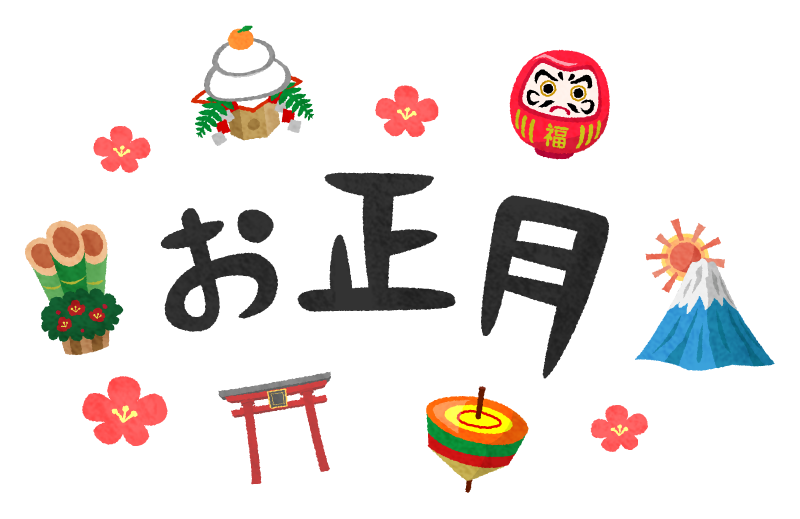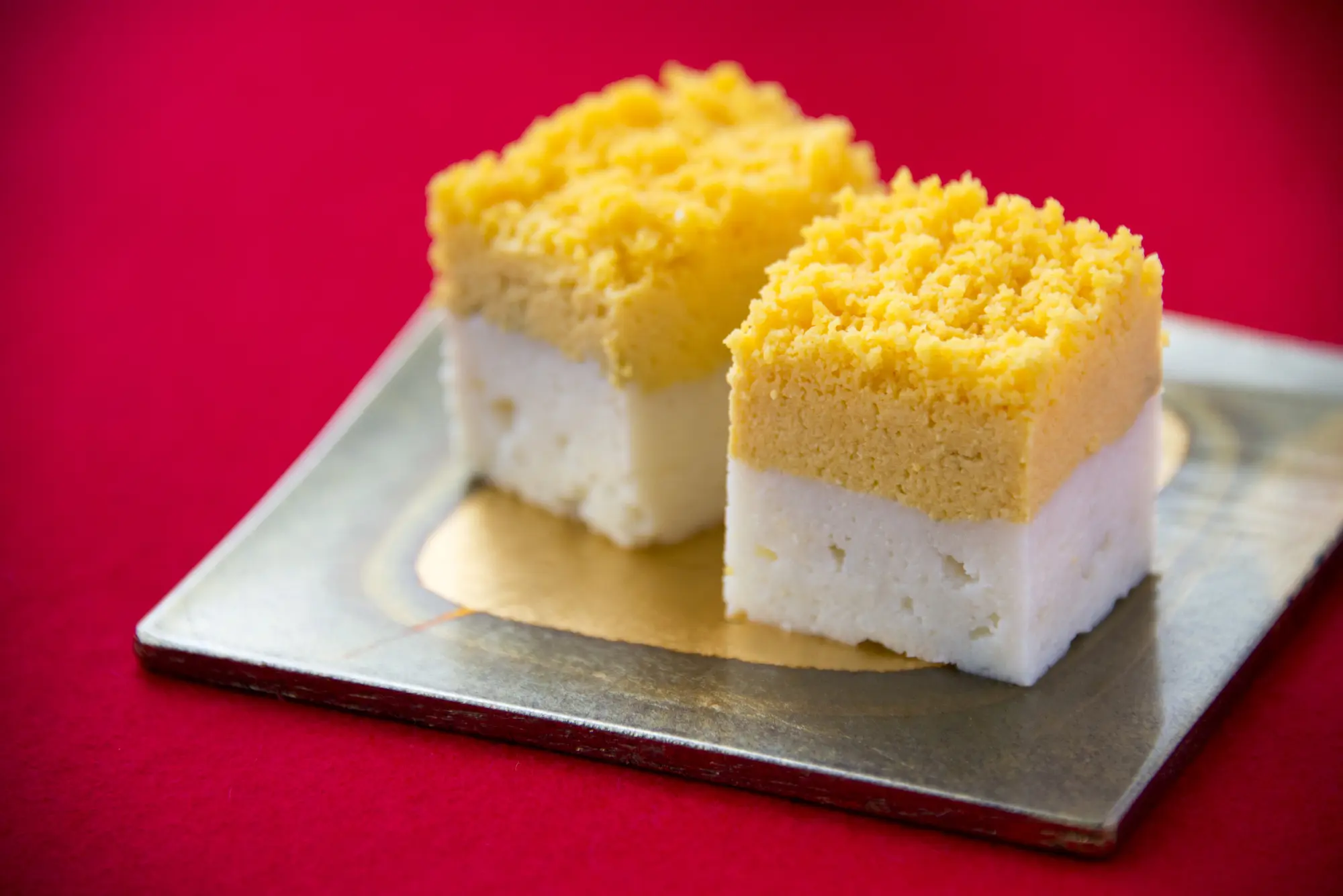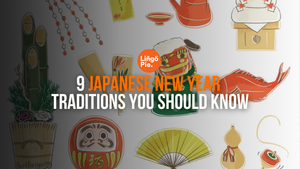Have you ever wondered how Japanese people celebrate New Year? In this article, we'll take a look at customs, traditions and events that are related to the celebration of the New Year in Japan, which it's a very meaningful time for Japanese people.
Personally, I enjoy the New Year celebration because I have a good time with my family, eating delicious food and with hopes renewed, with new projects on the horizon.
At some point of this article, we'll also see the meanings of one of the main dishes served during New Year, plus some related vocabulary and how to learn it in a fun way.
Let's start!
- Japanese Culture Day: A Celebration of Tradition and Heritage
- Tanabata Festival Guide + 15 Japanese Words You Should Know
- Thanksgiving in Japan: History, Food, Celebrations and More

How is New Year celebrated in Japan?
New Year or Oshōgatsu お正月 is a very important holiday in Japan because of its significance related to the year that ends and the new year that begins, leaving troubles behind and regaining hopes.
From January 1st to January 3rd, most people don't work, close their stores and spend time together with their families at home, eating New Year food, assiting to events and playing games.
During the last days of the year, friends and coworkers gather at izakayas 居酒屋 (Japanese taverns) and held parties known as bōnenkai 忘年会 to say goodbye to the year that's ending and leave all worries behind. In fact, the kanji bōnenkai is written with the kanji 忘 ("to forget"), 年 ("year") and 会 ("party", "gathering"), "the party to forget the year".
Decorations are also present in Oshōgatsu, like kadomatsu 門松 (pine decortations) and shimekazari しめ飾り (New Year's wreath). Families clean their houses during the ōsōji 大掃除 (big cleaning) and New Year greeting cards known as nengajō 年賀状 are given.
At New Year' Eve or Ōmisoka 大晦日, families gather and eat toshikoshi soba 年越しそば (literally "year-crossing buckwheat noodles"), a dish that simobolizes longevity. A TV music special known as Kōhaku Uta Gassen 紅白歌合戦 is watched. This TV show reunites J-Pop and enka singers to give awesome performances.
When the New Year comes, announced by the bells of the shrines (joya no kane 除夜の鐘), the first thing to do is to see the first sunrise of the year (hatsuhinode 初日の出). Kids are given money gifts (otoshidama お年玉) and osechiryōri お節料理, food gifts, is served. The ōsōji or big cleaning continues and people go to visit shrines or temples for the first time in the year. This is known as hatsumōde 初詣. This custom attracts a large number of people during the three days of Oshōgatsu.

What's osechi ryōri?
Osechi ryōri is New Year's most traditional Japanese food that's eaten to welcome the toshigami 年神, the New Year's gods, and each dish simbolizes a different type of good fortune.
The word osechi comes from sekku 節句, the name of the five seasonal festivals, such as Kodomo no Hi 子供の日 (Children's Day) or Tanabata 七夕 (Star Festival). Originally, the custom of eating food during sekku came from China, and osechi ryōri began to be eaten in New Year during the Heian Period (794-1185 A.D.).
This kind of food is served in big rectangular lacquer boxes called jūbako 重箱. Jūbako boxes are black on the outside and red on the inside, and this represents the wish for repeated luck. They are also tiered, and each tier comes with a different kind of food. For the 5-tiered jūbako, the top tier comes with appetizers to accompany drinks, the second one includes grilled and vinegar-dressed food, the third one more grilled food, and the fourth one steamed dishes. The fifth tier is often left empty to allow fortune to come in. What's more, the number of tiers varies from region to region.

Here are some dishes for osechi ryōri and what kind of good fortune they're associated with:
Daidai 代々/橙
Bitter Japanese orange. It symbolizes the wish for having children. That's why it's also written using the kanji 代 ("generation").

Datemaki 伊達巻
Sweet omelette roll filled with fish and shrimp paste. It represents wishes for the days to come.

Kamaboko 蒲鉾
Grilled fish cake. Its colors represent the Rising Sun.

Kazu no ko 数の子
Herring roe. It symbolizes the wish for having many children.

Konbu 昆布
A kind of seaweed. It symbolizes joy.

Kuromame 黒豆
Black soybeans. They represent health.

Tai 鯛
Bream, a kind of fish. It represents an important event that's yet to come.

Tazukuri 田づくり
Dried sardines. They symbolize a good harvest.

Ebi 海老
Shrimps cooked with sake and soy sauce. They represent the wish for a long life.

Nishiki tamago 錦卵/二色玉子
Two-colored egg roll. Yellow represents gold, and white represents silver. Both colors symbolize wealth.

The importance of the Japanese zodiac.
New Year celebrations in Western countries aren't related to the signs of the zodiac or at least most people don't do the connection. In Japan, however, New Year is strongly connected to the Japanese zodiac or eto 干支.
Like the Chinese one, the Japanese zodiac has 12 signs, each represented by an animal, with a 12 years cycle. In other words, every year is represented by a different animal following an order: Rat, Cow, Tiger, Rabbit, Dragon, Snake, Horse, Sheep, Monkey, Rooster, Dog and Wild boar. For instance, this year, 2024, is the Year of the Dragon. 2025 will be the Year of the Snake. The cycle repeats once the year of the Wild boar has ended, starting with the Rat again.

The eto is present in most New Year decorations, such as nengajō or New Year greeting cards, with the animal of the new year being featured everywhere. Also, eto is celebrated during hatsumōde or the first shrine visit of the year. Shrines are decorated with wooden plaques called ema 絵馬 featuring the animal of the New Year on the front side. On the back side, people that come to the shrine write prayers and wishes for the New Year.
So, don't be surprised if you see snakes everywhere this New Year in Japan!

Words and phrases for the New Year.
- Oshōgatsu お正月 : New Year (from January 1st to January 3rd).
- Ganjitsu 元日 : the first day of the year.
- Nenmatsu 年末 : the end of the year.
- Shinnen 新年 : New Year.
- Ōmisoka 大晦日 : New Year's Eve.
- Akemashite omedetō gozaimasu 明けましておめでとうございます : Happy New Year. It's often shortened to akemashite omedetō 明けましておめでとう.
- Yoi otoshi o omukae kudasai 良いお年をお迎えください : Have a happy New Year (said during New Year's Eve). It's often shortened to yoi otoshi o よいお年を.
- Kinga Shinnen 謹賀新年 : Happy New Year (more formal).
- Honnen mo yoroshiku onegaishimasu 本年もよろしくお願いします : "I look forward to your continued support this year". The word honnen 本年 can be replaced by kotoshi 今年, meaning "this year".
- Toshikoshi soba 年越しそば : year-crossing buckwheat noodles served during New Year's Eve simbolizing longevity.
- Osechi ryōri お節料理 : New Year's food gifts symbolizing many forms of good fortune and prepared to welcome the New Year's gods or toshigami 年神.
- Nengajō 年賀状 : New Year greeting card.
- Hatsumōde 初詣 : first shrine or temple visit of the year.
- Kagamimochi 鏡餅 : decorative rice cake.
- Otoshidama お年玉 : New Year's money gift given to kids.
- Joya no Kane 除夜の鐘 : New Year’s Eve bell ringing.
- Hatsuyume 初夢 : first dream of the year.
- Hatsuhinode 初日の出 : first sunrise of the year.
- Kōhaku Uta Gassen 紅白歌合戦 : annual singing contest held during New Year's Eve.
- Bōnenkai 忘年会 : party held by friends or coworkers to say goodbye to the year that's ending.
- Shinnenkai 新年会 : party held by friends or coworkers to receive the New Year during January.
- Ōsōji 大掃除 : the big cleaning.
- Eto 干支 : Japanese zodiac.
- Ema 絵馬 : a wooden plaque for decoration at shrines or temples featuring the zodiacal animal of the New Year on it. People that come to the shrine write on the back side prayers or wishes for the New Year.

Learn Japanese language and culture with Lingopie.
As you see, there are lots of customs and symbolism related to New Year in Japan. It isn't just eating, drinking and resting, but also having a good time with your loved ones and regaining hopes for the new year that's about to begin.
If you're interested in learning Japanese in 2025, I recommend you Lingopie. Lingopie offers a wide range of great and real Japanese TV shows, like anime, movies and music videos. You can learn lots of expressions and cultural background from your favorite shows and songs, and review them through quizzes and flashcards!
In addition, if you want to learn more about the phrases or situations shown in the shows you love, you can also book group or private lessons given by our professional teachers and tutors! Every lesson is based on scenes you watched in your favorite shows!
My final advice is for you to sign up for free and start the new year learning Japanese!
Yoi otoshi o よいお年を and Akemashite omedetō 明けましておめでとう everybody! See you in 2025!





![Happy New Year In Italian: 5+ Best Italian Greetings [Guide]](/blog/content/images/size/w1200/2024/12/Happy-New-Year-In-Italian.jpg)
![6 Best Japanese Language Apps Worth Trying [TESTED]](/blog/content/images/size/w300/2025/12/best-apps-to-Learn-Japanese.jpeg)
![A Guide To Kansai-ben Dialect For Beginners In Japanese [2026]](/blog/content/images/size/w300/2025/03/Kansai-ben-dialect.jpg)

